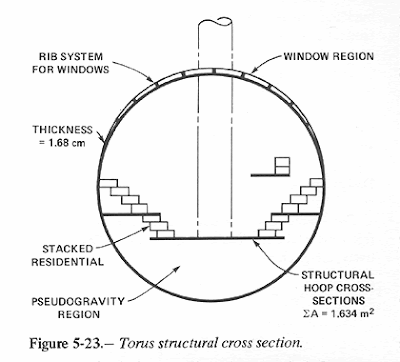 |
| Courtesy NASA |
In the summer of 1975, forty-three years ago, NASA and the American Society for Engineering Education sponsored a design study for space settlements. The technical director was no less than Gerard K. O’Neill, the famed physicist who studied and publicized what could be done with large space habitats. This NASA study laid out the fundamental design criteria; size, shape, material, etc.; that would be optimal for a space-based settlement. Based on the physical laws of the universe and strength of materials, much of this information is still valid, but a lot has happened since then. This get-together came about two years after Arthur C. Clarke published “Rendezvous With Rama” (see 3D tour), the story of a 30 mile diameter habitat from an alien race that enters the Solar System.
On this eve of great changes; with AI sages claiming the singularity is right around the corner, and climate scientists saying doom is nigh; we should take another look at how we might design and build comfortable habitats for a large population beyond the surly bonds of Earth.
We have more tools in the box than in 1975. Science and engineering have made great strides - 3D metal printing, graphene, mass-produced carbon fiber, carbon nanotubes, and artificial intelligence are but a few. Due to gravity, centripetal forces, geometry, and material strengths the NASA study came up with some basic shapes that one could use to build such a structure. This drawing shows those geometries while the next portrays a universal element that could be repeated to obtain these shapes.
 |
| Courtesy NASA |
 |
| Courtesy NASA |
The Stanford torus is one of the designs that came out of that 1975 study and uses one of the basic shapes. It is NASA in origin but takes the name from Stanford University, the site of the design exercise. One point eight kilometers in diameter, it rotates at one rpm to maintain a one g artificial gravity.
 |
| Courtesy Wikipedia |
 |
| Courtesy Wikipedia |
Here is the lunar mass driver proposed to deliver the 10 million tons of material required for the Stanford torus to be constructed at a nearby Lagrange point.
 |
| Courtesy Wikipedia |
An interesting combination of these shapes is the Bernal sphere. This was first conceived of by John Desmond Bernal in 1929. It combines the torus and sphere into a workable habitat where the heavily shielded sphere is where people work, and the torus bands are for agriculture. This design was later modified by O’Neill to form Island One and Island Two. Island Two is depicted in the pictures below.
 |
| Bernal sphere - courtesy Wikipedia |
 |
| Inside the Bernal sphere - courtesy Wikipedia |
 |
| Toroid sections of Bernal sphere - courtesy Wikipedia |
One major flaw in most of these designs from decades ago is the transparent sections left in the structure to allow sunlight to be reflected in by mirrors. Even though the glass or plastic will be thick enough to take structural loads from interior air pressure, it will not be effective at blocking cosmic radiation, the bugaboo of outer space. Cosmic rays can come from any direction with no warning. That’s why consideration of giving the agricultural sections less shielding to cut costs is another no-no. The living quarters of a space habitat have to be shielded from this radiation at all times. Sunlight will have to be ducted in through light tubes, or solar panels will power up thousands, maybe millions, of LED lights running through the center of the habitat to simulate sunlight.
Using the study’s conclusions about optimal shapes and sizes, there is a variation that would be advantageous structurally and aesthetically. More bang for the buck could be had by using the torus geometry in the multiple side-by-side configuration to form a cylindrical habitat. The tori would essentially serve as the structure for the cylinder, eliminating a lot of material while providing about twice the living space (at approximately one g) of the habitat alone. The following drawings graphically describe this configuration. Click on them to expand the view.
This configuration will have living, work, and recreation space for between 2 and 3 million people, including about 3/4 billion cubic feet of storage. It is 1.3 miles in diameter and 3.2 miles long. Method of construction will be 3D printed molds to be filled with a slurry of powdered asteroid or Moon regolith, water, binder, and strands of carbon nanotubes. The parts will then be deposited in giant plastic bags to recover the water vapor while they dry. When the parts are cured, they will be assembled by manned construction vehicles and unmanned drones resembling rocket-powered octopi.
Timeline: about 50 years hence. This will be when the first asteroid has been captured, corralled, and mined out. Realizing the unlimited future in space, the great flush of wealth produced will be used by the asteroid mining companies to fund projects similar to this habitat.
The alternative to this design is to take a mined-out asteroid and turn it into a habitat. Students and researchers at Delft University of Technology are currently working on turning a hollowed out asteroid into a vessel capable of traveling to other star systems - an even more ambitious project than that proposed here.
As we use up more resources, require more energy on our planet, and the climate becomes more hostile, we will look more often to the skies as a solution. It may get bad enough to view such habitats as preserves to maintain plants and animals that could be lost forever if left on Earth. In some ways, such a habitat may be safer and more comfortable than on Earth. There is no denying that once we escape the gravity well of Earth, the possibilities in space will seem endless as space itself.
Other articles you may enjoy:





No comments:
Post a Comment